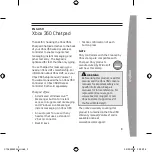
Instruction Manual
D200124X012
2500 and 2503 Controllers/Transmitters
June 2017
27
Startup
Adjustment locations are shown in figure 10. The pre‐startup or calibration procedures must be completed prior to
startup.
2500 Controller
1. Slowly open the upstream and downstream manual control valves in the pipeline. If the pipeline has a bypass valve,
close the valve.
2. If desired, adjust the proportional band to the narrowest (lowest) setting that maintains stable control. Proportional
band adjustments will affect the process level and may require a level adjustment. If adjusting proportional band,
make the adjustments in small increments.
3. To confirm the optimum proportional band setting, momentarily create a load upset. If cycling occurs, broaden
(increase) the proportional band until process oscillations diminish rapidly. In general, the narrowest proportional
band that does not produce cycling provides the best control.
2500T Transmitter
1. Make sure that the SPECIFIC GRAVITY and ZERO ADJUSTMENT controls are set according to the 2500 Controller or
2500T Transmitter portion of the pre‐startup checks procedures.
2. Slowly open the upstream and downstream manual control valves in the pipeline. If the pipeline has a manual
bypass valve, close the valve.
2500S Controller
1. Set the switching points according to the 2500S Controller portion of the prestartup checks procedures.
2. Slowly open the upstream and downstream manual control valves in the pipeline. If the pipeline has a manual
bypass valve, close the valve.
3. If necessary, the proportional band may be adjusted to increase or decrease the differential gap. Adjust the RAISE
LEVEL adjustment to reposition the differential gap. After readjustment, confirm the controller is still switching
correctly at both switching points.
2503 Controller
1. Set the switching points according to the 2503 Controller portion of the prestartup checks procedures.
2. Slowly open the upstream and downstream manual control valves in the pipeline. If the pipeline has a manual
bypass valve, close the valve.
3. If necessary, reposition the switching points by adjusting the RAISE LEVEL control. For example, if the differential
gap is set for 102 mm (4‐inches) of level change, this 102 mm (4‐inches) can be set anywhere within the length of
the displacer. After readjustment, confirm the controller is still switching correctly at both switching points.
Principle of Operation
The controller/transmitter receives the change in fluid level, fluid‐to‐fluid interface level, or density from the change in
the buoyant force the fluid exerts on the sensor displacer. The displacer, through a mechanical linkage, imparts a
rotary motion to the torque tube shaft. This rotary motion positions the flapper according to the level position of the
displacer; the nozzle/Bourdon tube arrangement sends a pneumatic signal to the relay valve.














































